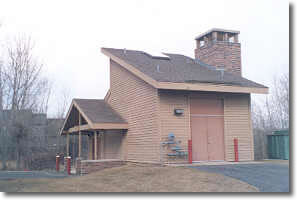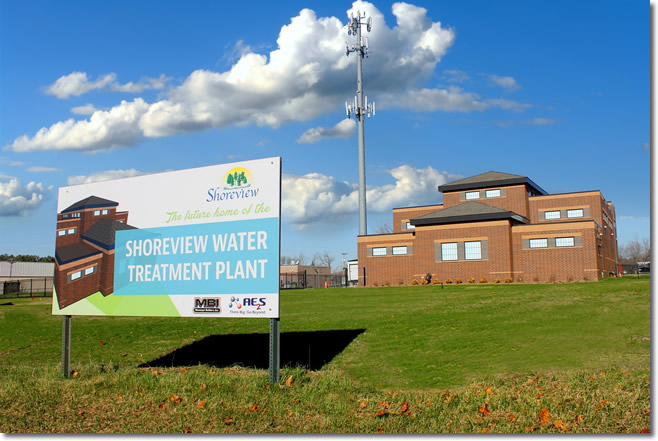Drinking Water Protection
- Drinking Water Protection Home
- About Us
- A-Z Index of Contaminants in Water
- Community Public Water Supply
- Drinking Water Grants and Loans
- Drinking Water Institute
- Drinking Water in Schools and Child Cares
- Drinking Water Revolving Fund
- Laws and Rules
- Noncommunity Public Water Supply
- Source Water Protection
- Water Operator and Certification Training
- Drinking Water Protection Contacts
Related Topics
- Annual Reports
- Drinking Water Risk Communication Toolkit
- Drinking Water Protection External Resources
- Fact Sheets
- Forms
- Invisible Heroes Videos: Minnesota's Drinking Water Providers
- Noncom Notes Newsletter
- Sample Collection Procedures (videos, pictures, written instructions)
- Waterline Newsletter
Related Sites
- 10 States Standards
- Clean Water Fund
- Health Risk Assessment – Guidance Values and Standards for Water
- Minnesota Well Index
- Water and Health
- Wells and Borings
Environmental Health Division
Hastings Removes Nitrate with New Plant
From the Summer 2011 Waterline
Quarterly Newsletter of the Minnesota Department of Health Public Water Supply Unit, Waterline
A complete list of feature stories can be found on the Waterline webpage.
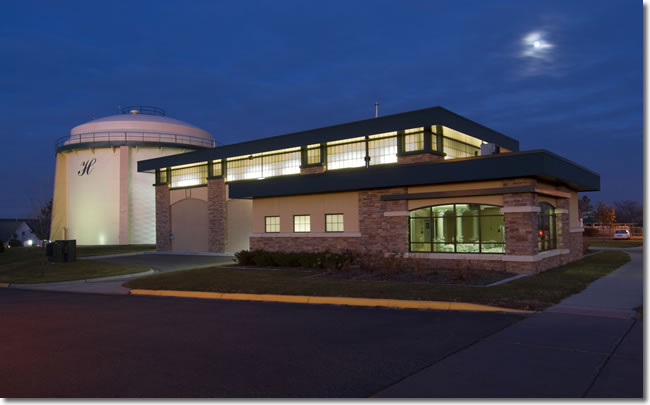 |
|
The city of Hastings recently opened its first water treatment plant. The plant, which treats water from two wells that have nitrate, is located in a populated area along a major highway. As a result, aesthetics were a concern in the exterior design. The plant has succeeded in both functions, reducing nitrate and providing a pleasing appearance. |
Tucked beneath bluffs and rolling hills amid the Mississippi, St. Croix, and Vermillion rivers, Hastings is a city with a rich heritage that includes being home to the first documented baseball team in Minnesota. The team was actually in Nininger City, now a part of Hastings, a planned community with the goal of becoming an “ultimate utopia” by Ignatius Donnelly, a lawyer, farmer, statesman, orator, and author who became one of the leading figures in Minnesota’s early years. Regardless of how completely Donnelly’s dream developed, Hastings has emerged into a thriving community of 22,000, with many residents who commute daily to the nearby Twin Cities and others who work in the immediate area.
For much of its history, Hastings served its citizens water straight from city wells, the only treatment being the addition of fluoride. That changed in recent years because of growing concerns about rising levels of nitrate in two municipal wells. “We didn’t feel very comfortable with that,” said Hastings public works superintendent John Zgoda. In 2006 the city began working with Kurt Johnson, an engineer then with TKDA, Inc. in St. Paul (and now with Bonestroo in Roseville) on a feasibility study to treat for nitrate removal.
Hastings draws its water from wells in the Jordan aquifer. Their water is exceptionally low in iron and manganese and doesn’t require treatment. However, nitrate in two wells, numbers 3 and 5, has been increasing and spiking at times toward the maximum contaminant level (MCL) of 10 parts per million (ppm). “We have seen a steady rise in nitrate levels in several of the city wells over a decade or longer,” said Johnson. “It became obvious that it was time for the city to act to ensure they maintained compliance with the nitrate MCL.”
Johnson explained some of the challenges of the region. “The geology available to develop wells within the city is very difficult. The Jordan [aquifer] has an eroded valley running through most of the city, and a major fault limits the use of the aquifer on the west side of the city. The Vermillion River water finds its way into the Shakopee [formation with the Prairie duChien aquifer], which is cracked and fissured and carries agricultural runoff, which is likely the source of the nitrate as it recharges the Jordan groundwater in the city.”
Johnson said they considered several options, including reverse osmosis, but rejected that. “Finding water is an issue,” Johnson said. “Membranes aren’t the greatest with a lot of spent water discharge.” Instead, they opted for anion-exchange treatment system with a new plant to treat the water from wells 3 and 5.
Tonka Equipment Company of Plymouth, Minnesota, supplied the system, which includes anion-exchange vessels, valves, facepiping, instrumentation, brinemaker, brine delivery components, a control system, and a softening system for brine make-up water to prevent calcium precipitation.
“The plant uses four anion-exchange vessels,” explained Tonka vice president Todd Butz, “each rated to treat up to 400 gpm [gallons per minute]. A portion of the 2,400 gpm total plant flow is treated through the units while the balance is bypassed around the anion exchange vessels and blended with the treated water to produce finished water with nitrate concentration consistently below the MCL.”
“It’s like we’re softening, but we’re not,” said Zgoda. “We’re using salt regeneration to get rid of the nitrate. It’s a different ion for nitrate removal than for softening. We’re doing a salt-brine solution to regenerate the vessels for the nitrate removal.”
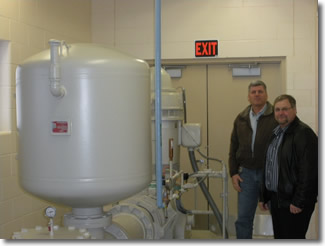 |
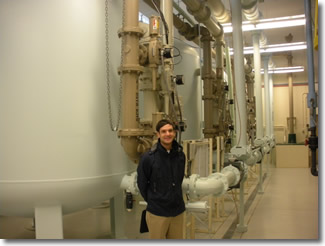 |
| Left: Mark Peine and John Zgoda of Hastings by Well No. 5. Right: Todd Butz by the four anion-exchange filters. | |
In addition to the treatment plant, Hastings has drilled two new wells while discontinuing two older ones. Well number 1, a multi-aquifer well that went into the Mount Simon aquifer and had a lot of iron, pumped only 300 gpm. Trichloroethylene was found in well 2, causing the city to cap it at the time well 7 went into service. Well 8, drilled to provide additional capacity to meet peak demand, was designed at the same time as the treatment plant.
Hastings now has six wells. Water from wells 4, 6, 7, and 8 is treated with fluoride and mixed with the water from wells 3 and 5, which is treated at the plant.
Hastings has a two-tiered distribution system, an elevated system, which supplies the growing development in the south and west ends of town, and one served by a 1 million gallon ground-storage reservoir by the treatment plant. The ground-storage system provides water to the downtown area.
Prior to the construction of the treatment plant, water from well 5, even though it is next to the ground-storage reservoir, went into the elevated system while well 3, to the east, came into the ground-storage system. Hastings can also bring water from the elevated to the ground-storage system and, since the installation of booster pumps in the 1990s, has been able to go from ground to elevated.
With the construction of the new plant, the ground-storage system is used as the utility’s clearwell, and wells 3 and 5 have been tied into the plant. Zgoda said the wells normally have raw-water levels of 8.8 ppm of nitrate, with the levels reaching between 9 and 9.2 ppm between February and April. Two of the other wells, 6 and 8, have nitrate levels between 7 and 7.8 ppm, and wells 4 and 7 have levels around 4 ppm.
About 60 percent of the water from wells 3 and 5 goes through the nitrate filters; the rest bypasses the filters and is blended with the filtered water. Some of this water goes into the ground-storage system, and three booster pumps can bring some to the elevated system. Hastings has a 750,000 gallon tower near the Dakota County Government Center, to the west of the plant, and a 1 million gallon tower by an industrial park to the east, off Minn. Hwy. 316.
A challenge the designers faced was related to the site of the plant, on the south side of Minn. Hwy. 55 in a growing residential area. “It’s very, very visible,” said Johnson. “All of a sudden this knob on the top of the hill, which was pretty wide open, became a lot more populated.” Johnson added that the 1950 vintage pumphouse already on the site “presented a dated architecture, and the blue color made it even more conspicuous. It was time for the city to improve the aesthetics of their facilities to complement the new development along the Highway 55 corridor.” The walls on the well house were knocked down and rebuilt as part of the building that houses the treatment equipment. Zgoda says the structure looks so nice that someone once came in because he thought it was a bank.
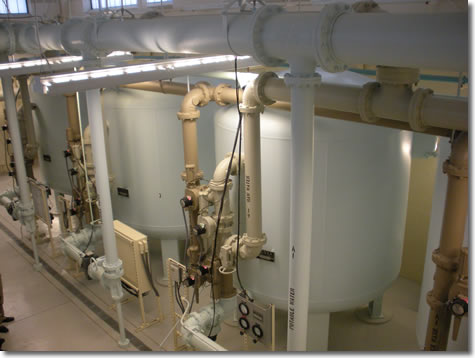 |
|
An overhead look at the filters. Below: the booster pumps. |
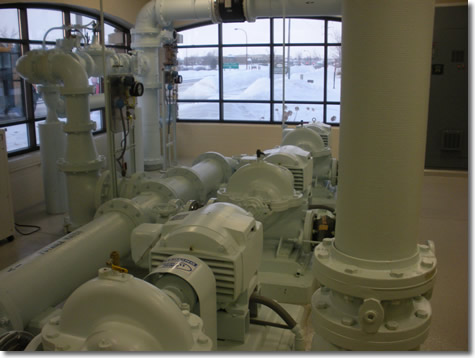 |
Hastings is now on quarterly monitoring because the finished water has been over 5 parts per million of nitrate, but Zgoda says, “We’re knocking it down below 5.” The plant went on-line in late 2008 and, after some adjustments were made, it has gone through a complete season. If the nitrate levels remain under 5, the utility may go to annual monitoring. For informational purposes, the city is working with the Minnesota Department of Health to monitor nitrate levels in the raw water as a means of measuring the effectiveness of the treatment.
The bypass/blend allows for the flexibility to adjust the treated/bypassed proportion for future compliance, should the raw-water nitrate level continue to increase. Hastings does not disinfect its water, but Johnson said that provisions were made to add chlorine in the future if desired.
The entire project, including two 12-inch mains between the plant and well 3, was approximately $3.5 million. No financing was needed as the city paid for the plant through its water fund.
Of Interest
Pumphouses Designed for Function as Well as Attractiveness
